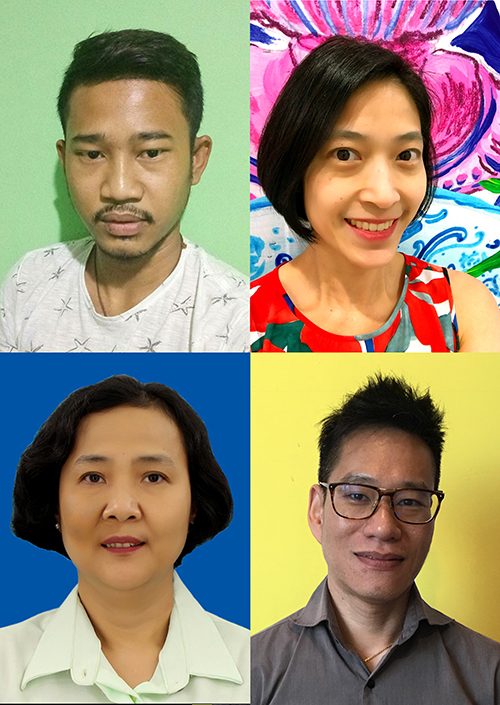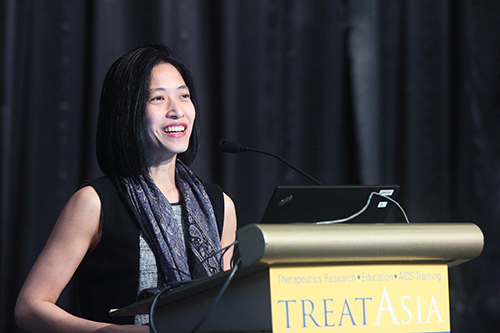At the beginning of 2018, we asked four experts living and working on the front lines of the epidemic to share their opinions about what needs to be done to end AIDS in the Asia-Pacific. Data from UNAIDS show that many countries in our region are still far behind global targets for HIV testing, treatment, and retention. These are some of the reasons why, along with suggestions for what can done to achieve progress.

(Clockwise, from top left) Sepi Maulana Ardiansyah, Dr. Nittaya Phanuphak, Martin Choo, Dr. Rossana Ditangco
Sepi Maulana Ardiansyah is a youth advocate working with Fokus Muda—Forum Populasi Kunci usia Muda, the Indonesian Young Key Population Network. He is a graduate of TREAT Asia’s Youth ACATA leadership training program.
For me, the highest priority in 2018 for ending AIDS is ensuring funding support for community groups, and addressing legal barriers to HIV services for young people. Funding support is increasingly limited, especially for investments in adolescents and PLHIV movements. However, many countries in the Asia-Pacific still need help and whatever support they can get to do more program interventions to reduce new infections and deaths due to AIDS among adolescents. In addition, legal barriers, such as of informed consent for adolescents under the age of 18 years who cannot get HIV testing without their parents’ permission, lowers access to healthcare providers, especially in Indonesia.
 Sepi Maulana Ardiansyah (left) with fellow youth advocate MikeQ from the Thai Network of Youth Living with HIV (TNY+)
Sepi Maulana Ardiansyah (left) with fellow youth advocate MikeQ from the Thai Network of Youth Living with HIV (TNY+)
Dr. Nittaya Phanuphak is the Chief of Prevention and Chief of SEARCH (South East Asia Research Collaboration on HIV) at the Thai Red Cross AIDS Research Centre in Bangkok, Thailand. Dr. Phanuphak is a TREAT Asia Network investigator and a powerful advocate for scale-up of HIV prevention, testing, and treatment to end AIDS in Thailand by 2030.
To end AIDS in our region, the highest priority for me in 2018 is the “sense of urgency.” The urgency to speed up everything we are doing at every step of the double-sided HIV cascade: the treatment side and the prevention side. We have not been using all existing tools to their maximum benefit, and it seems like we were hallucinating that we were already doing our best.
Have we effectively used same-hour HIV testing? And when will HIV self-testing be legally registered in our country? Have we truly initiated ART [antiretroviral therapy] for all in our clinics? Why can't ART be started on the same day of HIV diagnosis? When will we use HIV viral load monitoring more effectively to track ART response, to empower the U=U [undetectable=untransmittable] message, and to reduce stigma and fear of HIV in society? When will we stop fantasizing PrEP as always being used with condoms? We are too slow at every step. We have known about PrEP since 2010. The first PrEP program was launched in 2014 in Thailand. By the end of 2017, we have only had 5,000 people on PrEP, while we know there are more than 100,000 people among key populations at high risk for HIV in our country. The urgency to genuinely engage key populations in the design and delivery of HIV services is also crucial in every country. A sense of urgency is the highest priority this year if we are to end AIDS in the next decade.
Dr. Rossana Ditangco is the Head of the AIDS Research Group of the Department of Health, Research Institute for Tropical Medicine, in Manila, the Philippines. Dr. Ditangco is a founding member of the TREAT Asia Network, and a co-investigator on Project PrEPPY, a pilot implementation project of HIV pre-exposure prophylaxis in the Philippines.
The highest priority for 2018 is to work towards reaching the 90% HIV testing target. Testing is not only a gateway to treatment but an opportunity to offer prevention interventions as well. The target will never be reached if the “business as usual” approach is maintained. Government and partners should be aggressive in terms of investments, testing policies and targets. A lot of people who need to get tested for HIV are unrecognized because they are in places traditionally identified as “low risk,” and testing is thought to be a “waste of resources.” Active case finding and universal testing coverage may be costly in the medium term, but the long-term benefit to reverse and eventually end the epidemic would all be worth it.
 Dr. Nittaya Phanuphak speaking at a TREAT Asia Network Meeting
Dr. Nittaya Phanuphak speaking at a TREAT Asia Network Meeting
Martin Choo is the General Manager of the Kuala Lumpur AIDS Support Services Society (KLASS) in Malaysia and an activist working towards equitable access to HIV treatment. He is a Trustee of the Asia Pacific Council of AIDS Service Organizations (APCASO), and has been living with HIV since 2004.
Our highest priority in 2018 is to focus on sexual health among our youth. In Malaysia, the majority of newly diagnosed cases of HIV are among young people below the age of 30. Despite having transitioned to a mostly sexually transmitted HIV epidemic in 2010, there are few efforts to educate our youth on sexual health or increase their awareness on the many options for safer sex, which should include not only HIV/STI screening and condom use, but also pre-exposure prophylaxis (PrEP) and treatment as prevention for HIV.
Authorities often cite cultural, social, and religious sensitivities for dragging their feet. As they delay giving out necessary information, the proliferation of online social networking tools is exponentially increasing connections for sex. The fact that the Asia Pacific is where 60% of the world’s youth lived in 2017, according to the United Nations, and has some of the highest rates of internet penetration in the world, should give us pause for thought. Compounding the issue, existing efforts on sexual health, where available, are often not comprehensive enough to include peer-driven information on sexuality, gender identity, and expression, or savvy enough to cover the experimentation with licit and illicit substances during sex—even though it is well known that social identity, self-expression and sexual experimentation matter to young people. The lack of awareness on sexual and gender diversity can keep some youth at the margins of society, further disenfranchising their access to HIV testing, treatment, and care, and augmenting any social and self-stigma they may already have concerning sex.
These concerns are neither inconsequential nor benign. During the recent Malaysian Ministry of Health technical review panel meeting, it was reported that the 2017 Integrated Bio-Behavioural Surveillance Survey among men who have sex with men in Kuala Lumpur found HIV prevalence could be as high as 42%. As we check and debate the veracity of this figure, it is imperative we put aside our prejudices and dig deep to find the political will to start nurturing in earnest the sexual health of our youth. Otherwise, any pronouncement and strategy on ending AIDS this century could prove to be ineffectual lip service.